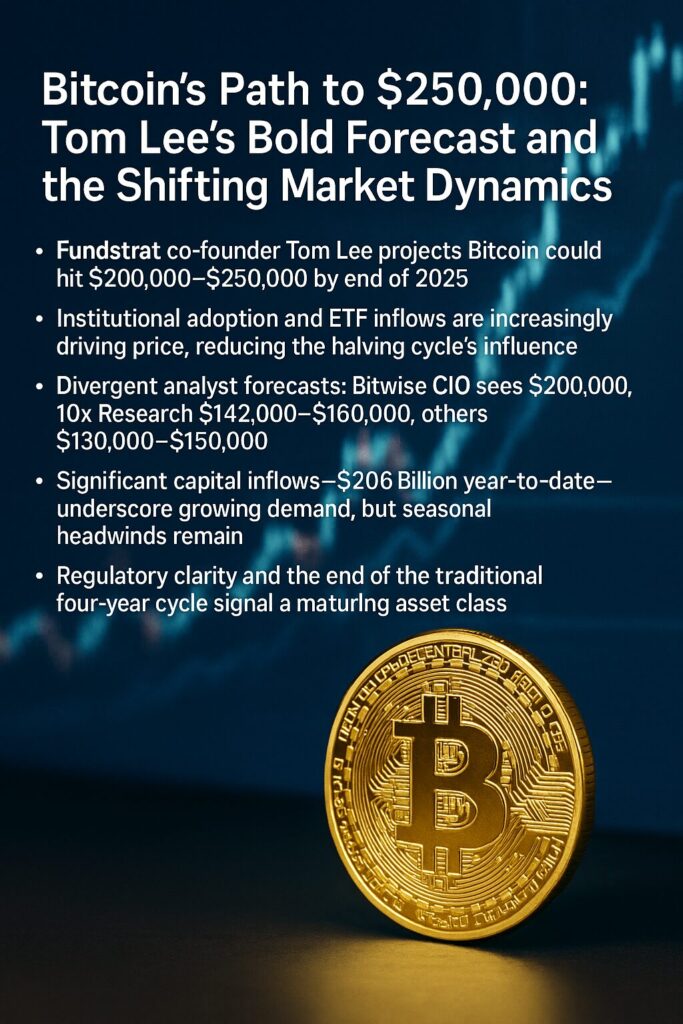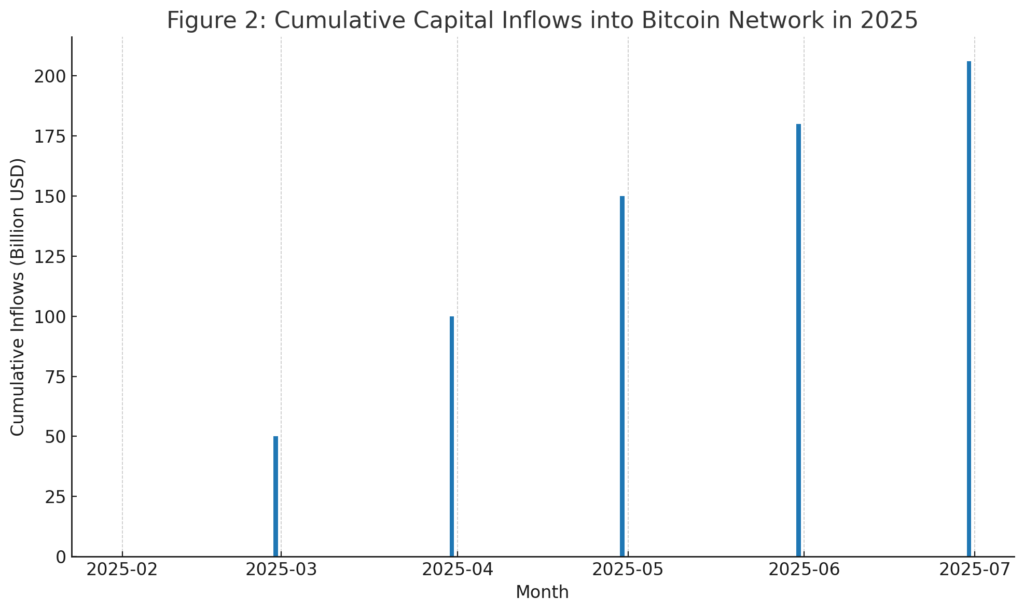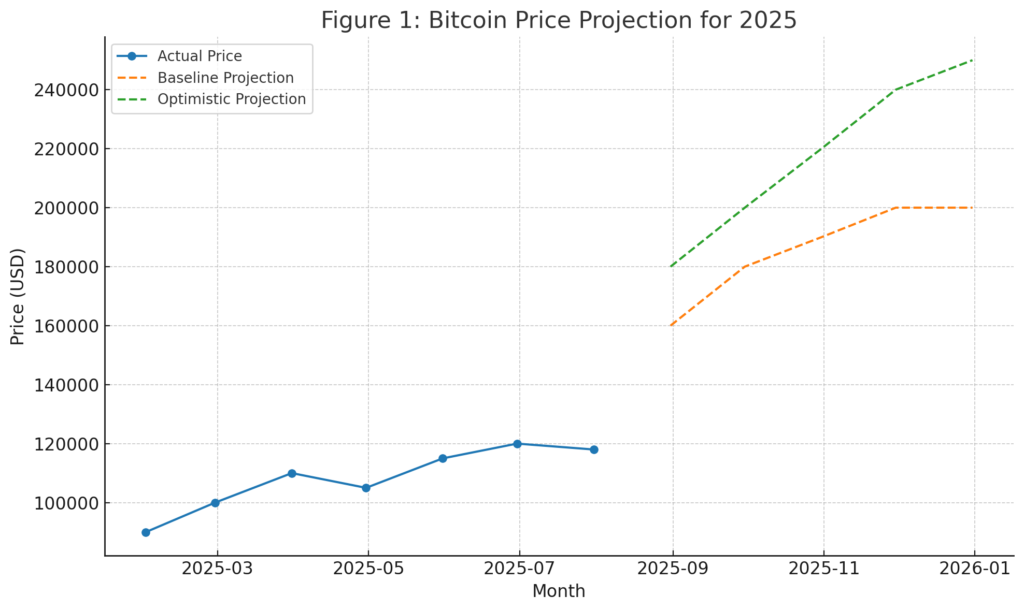
Main Points:
- Fundstrat co-founder Tom Lee projects Bitcoin could hit $200,000–$250,000 by end of 2025
- Institutional adoption and ETF inflows are increasingly driving price, reducing the halving cycle’s influence
- Divergent analyst forecasts: Bitwise CIO sees $200,000, 10x Research $142,000–$160,000, others $130,000–$150,000
- Significant capital inflows—$206 billion year-to-date—underscore growing demand, but seasonal headwinds remain
- Regulatory clarity and the end of the traditional four-year cycle signal a maturing asset class
Introduction
Bitcoin’s remarkable volatility has become a hallmark of digital assets, but 2025 may mark a turning point. Fundstrat’s co-founder Tom Lee recently forecast that Bitcoin could surge past $200,000 and potentially reach $250,000 by year-end. This article examines Lee’s reasoning, places it within the broader landscape of market forecasts, and explores the evolving forces—particularly institutional adoption and regulatory developments—that are reshaping Bitcoin’s price trajectory.
1. Tom Lee’s $250,000 Prediction
In an August 6 interview with CoinStory, Tom Lee reaffirmed his bullish stance, stating that Bitcoin may break $120,000 in the second half of 2025 and ultimately climb to $200,000–$250,000 by December. He attributes this potential to a growing wave of institutional interest, which he believes has become the primary price driver, overshadowing the traditional four-year halving cycle.
Lee argues that valuing Bitcoin at 25% of gold’s market capitalization supports a price above $1 million in the long term, making a $250,000 year-end price a conservative stepping stone. The prediction rests on sustained ETF inflows and corporate treasury allocations, which have already begun to dwarf retail-driven cycles.
2. The End of the Four-Year Cycle
Historically, Bitcoin experienced pronounced bull and bear phases tied to its halving events, occurring roughly every four years. However, Bitwise CIO Matt Hougan recently declared that the “four-year cycle is dead,” citing deeper structural shifts. He points to the approval of spot Bitcoin ETFs in January 2024 and clearer regulatory frameworks—most notably the GENIUS Act—as forces that have broken the pattern of price peaks following halvings. As a result, he predicts a more sustained bull market in 2026 rather than a traditional post-halving pullback.
3. Divergent Analyst Forecasts
While Lee’s $250,000 projection has garnered attention, other analysts present a range of year-end targets:
- Bitwise (Matt Hougan): $200,000, emphasizing institutional ETF demand and regulatory clarity.
- 10x Research (Markus Thielen): $140,000–$160,000, based on fading seasonal momentum and capital inflow trends.
- Bernstein & Standard Chartered: ~$200,000, pointing to macroeconomic tailwinds but cautioning downside risks.
- 10x Research Updated: $142,000, noting that $206 billion has already flowed into Bitcoin this year and an additional $81 billion may be required to hit that level.
These forecasts reflect differing views on how much new money can enter the market amid seasonal headwinds and a potential summer consolidation phase.
4. Institutional Adoption and Capital Flows
Institutional investment has become the bulwark of Bitcoin’s rally. In 2025, cumulative capital inflows into the Bitcoin network reached $206 billion, driven largely by spot ETF subscriptions and corporate treasury buys. Analysts note that even single-day ETF inflows of 10,000 BTC can have outsized price impacts given the daily issuance of only 450 BTC through mining.
Figure 2: Insert after this paragraph.

Markus Thielen of 10x Research warns that a 30-day average inflow slowdown—from $62.4 billion to $59.3 billion—could foreshadow a consolidation, but past outlier months in 2013, 2017, and 2021 suggest 2025 might buck the trend.
Figure 1: Price Projections
Insert here after “Price Projections” heading.

5. Price Projections
Drawing on Lee’s outlook and other forecasts, Figure 1 illustrates actual monthly prices through July and baseline ($200,000) and optimistic ($250,000) projections for the remainder of 2025. The chart highlights the steep climb needed in Q4 to meet Lee’s upper bound, as well as a more conservative trajectory aligned with Bitwise’s $200,000 target.
6. Regulatory and Macro Drivers
Regulatory frameworks such as the GENIUS Act have provided clarity, reducing perceived blow-up risks and opening the door for pension funds and endowments. Concurrently, macroeconomic factors—rising deficits, looser monetary policy, and inflation concerns—have positioned Bitcoin as a hedge, akin to digital gold. Cathie Wood of ARK predicts Bitcoin could reach $1.5 million by 2030, emphasizing long-term institutional allocations.
Conclusion
Bitcoin’s journey toward $250,000 by the end of 2025 hinges on the pace and scale of institutional adoption, regulatory clarity, and macroeconomic pressures. Tom Lee’s bold projection underscores the transition from halving-driven cycles to an era defined by ETFs and corporate flows. While analysts remain divided—with forecasts ranging from $140,000 to $250,000—the consensus is clear: Bitcoin is maturing into a macro asset, and sustained inflows rather than scheduled supply shocks will dictate its path. Investors seeking new crypto assets and practical blockchain applications should monitor ETF flows, regulatory developments, and capital-inflow metrics as leading indicators of Bitcoin’s next leg up.

